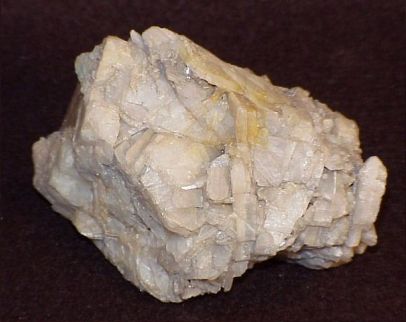The Mineral albite

Albite belongs to the Plagioclase Feldspar group, an isomorphous solid solution series. Albite is one end member, containing sodium and no calcium. The other end member, Anorthite, contains calcium and no sodium. The intermediary members are Oligoclase, Andesine, Labradorite, and Bytownite. Oligoclase and Andesine are considered by some to be a variety of Albite rather then a separate mineral. The acclaimed Dana's System of Mineralogy lists these intermediary members as individual minerals, whereas the IMA does not recognize them as individual mineral species.
Albite also forms a series with Sanidine, and the intermediary member of this series is Anorthoclase. Albite can contain up to ten percent potassium replacing the sodium. If more than ten percent replaces the sodium, the mineral is no longer Albite, but Anorthoclase.
Albite is a very common mineral, and is an important rock-forming mineral. It takes a longer time for Albite to crystallize than the other feldspars. This enables Albite to form in large and well crystallized examples. Albite is also a common accessory mineral to many rare and unusual minerals.
The iridescent variety Peristerite sometimes exhibits an adularescent sheen. This produces an unusual form of Moonstone.
Albite sometimes forms in association with the feldspar mineral Microcline in alternating patterns, and forms a
feldspar rock known as Perthite.
Chemical Formula
NaAlSi3O8
Color
White, colorless, cream, light yellow, light blue, light green, pale red, light brown, gray. Some Albite is iridescent with schillers.
Properties
Streak
White |
Hardness
6 - 6.5 |
Transparency
Transparent to translucent |
Specific Gravity
2.6 - 2.63 |
Luster
Vitreous to pearly |
Cleavage
2,1 - basal ; 2,1 - prismatic ; 3,1 - pinacoidal. The cleavage angle is about 90º. |
Fracture
Subconchoidal to uneven |
Tenacity
Brittle |
Varieties
-
Albite containing a small percentage of potassium replacing the sodium. The ratio of sodium to potassium must be greater than 9:1, otherwise the mineral is Anorthoclase.
-
Iridescent variety of Albite. Its color sheen is similar to Labradorite but not as pronounced and is usually on a white or light colored background.
Uses
Albite is industrially important in the manufacture of ceramics. Albite provides the best crystallized examples of the Plagioclase Feldspars, and these crystals are popular among collectors. Albite is also important in the study of mineral environments and crystal formations.
Noteworthy Localities
Albite is a very common mineral, but localities where fine Albite crystals can be found are more limited. Some excellent examples have come from the Swiss Alps and the Tyrol, Austria. Large, well formed crystals come from the pegmatites of Gilgit, Pakistan; and Nuristan, Afghanistan. Enormous Clevelandite crystals have come from several areas in Minas Gerais, Brazil, especially in the Doce and Jequetinhonha Valleys.
In Canada, Albite was found in Quebec at the Francon quarry, Montreal; and at Mount St.-Hilaire, Quebec.
In the U.S., some of the best and clearest crystals are from Amelia Court House, Amelia Co., Virginia. Other important localities are Pala, San Diego Co.,California; the Little Three mine, Ramona, San Diego Co., California; the Foote Spodumene mine, Kings Mt., Cleveland Co., North Carolina; and Auburn, Androscoggin Co., Maine.
Distingushing Similar Minerals
Potassium Feldspar Group - Don't exhibit striations on twinned crystal surfaces, whereas the Plagioclase feldspars sometimes do. Otherwise can be difficult to distinguish.
Other Plagioclase Feldspars - Usually cannot be determined by practical means.
Spodumene - Has a splintery fracture.
Barite - Lower hardnessand much heavier.
Calcite - Much lower hardness.